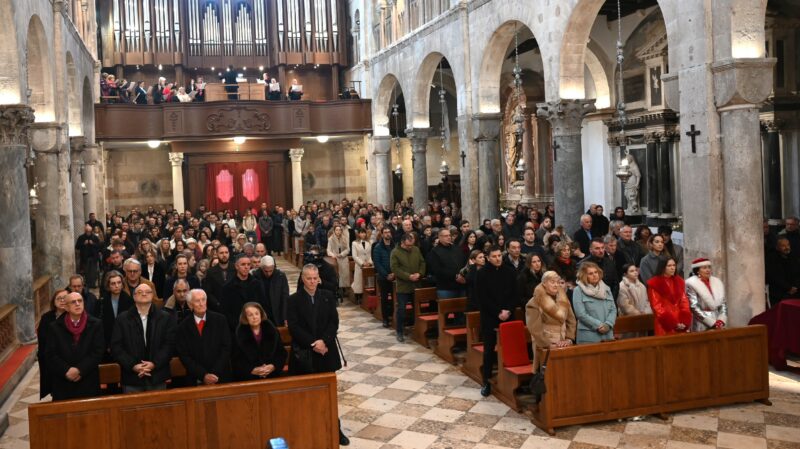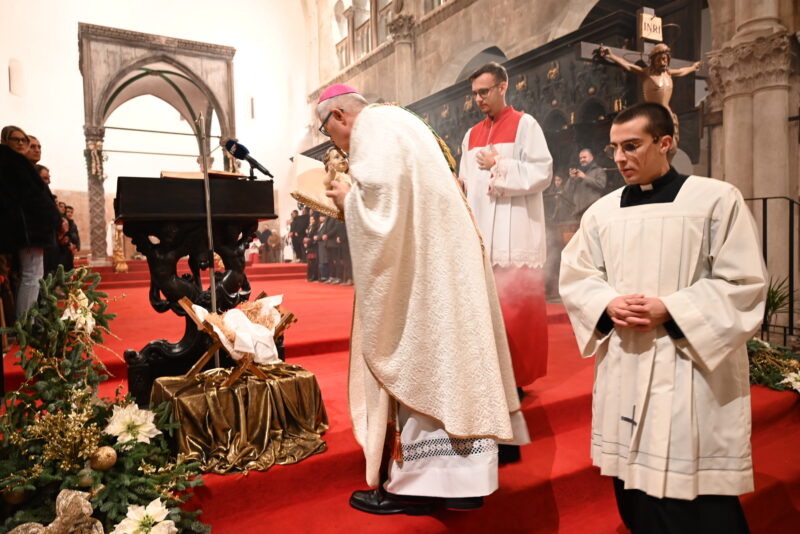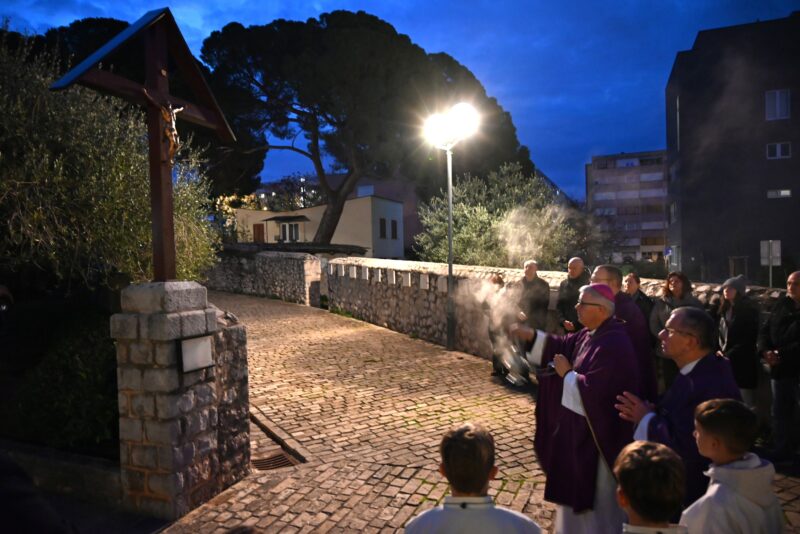Kripta i prezbiterij
Izaberi jezik | Choose a language
- HRVATSKI
- ENGLISH
- DEUTSCH
- ITALIANO
- FRANÇAIS
- PORTUGUÊS
- РУССКИЙ
- MAGYAR
- POLSKI
- ESPAÑOL
Kripta i prezbiterij
Prezbiterij je povišeniji u odnosu na ostali dio katedrale, a ispod njega nalazi se kripta iz 12. stoljeća. Kripta je nastala s izgradnjom nove bazilike, a ukopana je duboko ispod prezbiterija koji je izrastao iz opsega kripte. Zanimljivo je da kripta punom mjerom stoji sva u širini samo ispod glavne lađe, što je različito od romaničkih kripti koje se prostiru ispod prezbiterija u punoj širini bazilike, kao npr. u bazilikama srednje Italije. Četiri stupa u sredini kripte deblja su od ostalih i postavljeni su u kvadratu ispod glavnoga oltara u svetištu. Oni nose konfesiju smještenu među svodovima. Konfesija je zatvorena komora smještena upravo ispod glavnoga oltara u svetištu, a imala je mali prozorčić, fenestella confessionis, koja je vjernike povezivala s relikvijama triju solunskih svetica: sv. Agape, sv. Irene i sv. Kione.
Glavni oltar u prezbiteriju u sadašnjem obliku složen je od triju srodnih pluteja iz 8/9. stoljeća. Klesani dijelovi bili su okrenuti prema unutarnjoj strani pa stoga nisu bili vidljivi sve do obnove u 20. stoljeću. Nad glavnim oltarom nalazi se gotički ciborij iz 1332. godine u čijem stropu je lik Jaganjca Božjeg. Iza oltara nalazi se mjesto za nadbiskupa; kameno prijestolje iz 12. stoljeća (katedra) i subselij, mjesto za svećenike.
U prezbiteriju su smještena i korska sjedala izrađena u stilu cvjetne gotike (gotico fiorito). Izradio ih je rezbar Mateo Moronzon iz Venecije u prvoj polovici 15. stoljeća. Na gornjoj lijevoj strani nalazi se nadbiskupska katedra, nasuprot koje je mjesto za gradskog kneza.
The crypt and the presbytery
The presbytery is higher than the rest of the cathedral, and below it is a crypt from the 12th century. The crypt was created with the construction of the new basilica and was buried deep under the presbytery that grew out of the crypt. It is interesting that the full width of the crypt is only under the main nave, which is different from the Romanesque crypts that extend under the presbytery in the full width of the basilica, such as in the basilicas of central Italy. The four pillars in the middle of the crypt are thicker than the others and are placed in a square below the main altar in the sanctuary. They carry the confession placed between the vaults. The confessional is a closed chamber located just below the main altar in the sanctuary, and it had a small window, the fenestella confessionis, which connected the faithful with the relics of three saints of Salona: St. Agape, St. Irene and St. Kion.
The high altar of the sanctuary in present form is composed of three connected plutei from the 8th or 9th century. The carved parts were facing inward and thus were not visible until the 20th century restoration. Above the high altar is a Gothic ciborium from 1332., in the ceiling of which is a relief of the Lamb of God. Behind the altar is the seat for the archbishop – a stone throne (cathedra) from the 12th century – and a subselium, a place for priests.
The presbytery also holds the corset seats made in the floral Gothic style. They were made by the carver Mateo Moronzon of Venice in the first half of the 15th century. On the upper left is the archiepiscopal cathedra, opposite which is the seat of the city duke.
Die Krypta und das Presbyterium
Das Presbyterium liegt höher als der Rest der Kathedrale, und unter ihm befindet sich eine Krypta aus dem 12. Jh. Sie entstand beim Bau der neuen Basilika und wurde tief unter das Presbyterium gegraben, das sich über der Krypta erstreckt. Interessant ist, dass sich die Krypta in ihrer Breite nur unter dem Hauptschiff befindet, was sie von den üblichen romanischen Krypten unterscheidet, die sich unter dem Presbyterium über die gesamte Breite der Basilika erstrecken, wie z.B. in den Basiliken Mittelitaliens. Die vier Säulen in der Mitte der Krypta sind dicker als die anderen und befinden sich in einem Quadrat unter dem Hauptaltar im Altarraum. Sie tragen die Confessio, die sich zwischen den Gewölben befindet. Die Confessio ist ein geschlossener Raum direkt unter dem Hauptaltar. Ein kleines Fenster, die fenestella confessionis, verband die Gläubigen mit den dort aufbewahrten Reliquien der drei Heiligen von Salona: Agape, Irene und Chionia.
Der im Presbyterium gelegene Hauptaltar in seiner heutigen Form besteht aus drei miteinander verbundenen Plutei aus dem 8./9. Jh. Die geschnitzten Teile waren nach innen gerichtet und daher bis zur Restaurierung im 20. Jh nicht sichtbar. Über dem Hochaltar befindet sich ein gotisches Ziborium aus dem Jahr 1332, in dessen Decke ein Relief mit dem Lamm Gottes zu sehen ist. Hinter dem Altar befindet sich der Sitz des Erzbischofs – ein steinerner Thron (Kathedra) aus dem 12. Jh. – und das Subsellium, die Bank für die Priester.
Im Presbyterium befindet sich auch das Chorgestühl im floralen gotischen Stil, gefertigt durch den Schnitzer Mateo Moronzon aus Venedig in der ersten Hälfte des 15. Jh. Links oben befindet sich die erzbischöfliche Kathedra und ihr gegenüber der Sitz des Stadtfürsten.
La cripta e il presbiterio
Il presbiterio è più alto rispetto al resto della cattedrale e sotto di esso si trova una cripta del XII secolo. La cripta è stata creata con la costruzione della nuova basilica ed è stata sepolta in profondità sotto il presbiterio che è cresciuto dalla cripta. È interessante notare che l’intera larghezza della cripta si trova solo sotto la navata principale, a differenza delle cripte romaniche che si estendono sotto il presbiterio per tutta la larghezza della basilica, come nelle basiliche dell’Italia centrale. I quattro pilastri al centro della cripta sono più spessi degli altri e sono disposti a quadrato sotto l’altare principale del santuario. Portano la confessione posta tra le volte. Il confessium è una camera chiusa situata proprio sotto l’altare principale del santuario e aveva una piccola finestra, la fenestella confessionis, che metteva in comunicazione i fedeli con le reliquie di tre Sante di Salonicco: Agape, Irene e Kion.
L’altare maggiore del santuario nella forma attuale è composto da tre plutei collegati tra loro, risalenti all’VIII o al IX secolo. Le parti scolpite erano rivolte verso l’interno e quindi non erano visibili fino al restauro del XX secolo. Sopra l’altare maggiore si trova un ciborio gotico del 1332, sul cui soffitto si trova un rilievo dell’Agnello di Dio. Dietro l’altare si trova la sede dell’arcivescovo – un trono in pietra (cathedra) del XII secolo – e un subselium, un luogo per i sacerdoti.
Nel presbiterio si trovano anche i sedili a corsetto realizzati in stile gotico floreale. Sono stati realizzati dall’intagliatore Mateo Moronzon di Venezia nella prima metà del XV secolo. In alto a sinistra si trova la cattedra arcivescovile, di fronte alla quale si trova la sede del duca della città.
La crypte et le presbytère
Le presbytère est plus haut que le reste de la cathédrale, et sous lui se trouve une crypte du XIIe siècle. La crypte a été créée lors de la construction de la nouvelle basilique et a été enterrée profondément sous le presbytère qui a grandi à partir de la crypte. Il est intéressant de noter que la crypte ne s’étend sur toute sa largeur que sous la nef principale, ce qui est différent des cryptes romanes qui s’étendent sous le presbytère sur toute la largeur de la basilique, comme c’est le cas dans les basiliques d’Italie centrale. Les quatre piliers du milieu de la crypte sont plus épais que les autres et sont placés en carré sous le maître-autel du sanctuaire. Ils portent la confession placée entre les voûtes. Le confessionnal est une chambre fermée située juste en dessous de l’autel principal du sanctuaire. Il possédait une petite fenêtre, la fenestella confessionis, qui mettait les fidèles en contact avec les reliques de trois saints de Salona : Agape, Irène et Kion.
Le maître-autel du sanctuaire dans sa forme actuelle est composé de trois plutei reliés entre eux datant du VIIIe ou IXe siècle. Les parties sculptées étaient tournées vers l’intérieur et n’étaient donc pas visibles jusqu’à la restauration du XXe siècle. Au-dessus du maître-autel se trouve un ciboire gothique de 1332, dont le plafond est orné d’un relief représentant l’Agneau de Dieu. Derrière l’autel se trouvent le siège de l’archevêque – un trône en pierre (cathedra) du XIIe siècle – et un subselium, un endroit pour les prêtres.
Le presbytère abrite également les sièges de corset réalisés dans le style gothique floral. Ils ont été réalisés par le sculpteur Mateo Moronzon de Venise dans la première moitié du XVe siècle. En haut à gauche se trouve la cathèdre archiépiscopale, en face de laquelle se trouve le siège du duc de la ville.
A cripta e o presbitério
O presbitério é mais alto do que o resto da catedral, e por baixo dele encontra-se uma cripta do século XII. A cripta foi criada com a construção da nova basílica e foi enterrada profundamente sob o presbitério que cresceu a partir da cripta. É interessante o facto de a largura total da cripta estar apenas sob a nave principal, o que é diferente das criptas românicas que se estendem sob o presbitério a toda a largura da basílica, como nas basílicas da Itália central. Os quatro pilares do centro da cripta são mais grossos do que os outros e estão dispostos num quadrado por baixo do altar-mor do santuário. São eles que transportam a confissão colocada entre as abóbadas. O confessionário é uma câmara fechada, situada logo abaixo do altar-mor do santuário, e tinha uma pequena janela, a fenestella confessionis, que ligava os fiéis às relíquias de três santos de Salona: Santo Ágape, Santa Irene e São Kion.
O altar-mor do santuário, na sua forma atual, é composto por três plutei ligados entre si, do século VIII ou IX. As partes esculpidas estavam viradas para o interior e, por isso, não eram visíveis até ao restauro do século XX. Por cima do altar-mor está um cibório gótico de 1332, em cujo teto se encontra um relevo do Cordeiro de Deus. Atrás do altar, encontra-se o assento do arcebispo – um trono de pedra (cathedra) do século XII – e um subselium, um lugar para os sacerdotes.
O presbitério alberga também os assentos de espartilho em estilo gótico floral. Foram realizados pelo entalhador Mateo Moronzon, de Veneza, na primeira metade do século XV. No canto superior esquerdo encontra-se a cátedra arquiepiscopal, em frente da qual se situa a sede do duque da cidade.
Крипта и пресвитерий
Пресвитерий выше, чем остальная часть собора, а под ним находится крипта XII века. Крипта была создана при строительстве новой базилики и погребена глубоко под пресвитерием, который вырос из крипты. Интересно, что вся ширина крипты находится только под главным нефом, что отличается от романских крипт, которые простираются под пресвитерием на всю ширину базилики, как, например, в базиликах центральной Италии. Четыре столба в центре крипты толще остальных и расположены в виде квадрата под главным алтарем в святилище. Они несут исповедальню, расположенную между сводами. Исповедальня – это закрытая камера, расположенная чуть ниже главного алтаря в святилище, в ней было небольшое окно, fenestella confessionis, которое связывало верующих с мощами трех салонских святых: Святой Агапии, Святой Ирины и Святого Киона.
Главный алтарь святилища в нынешнем виде состоит из трех соединенных между собой плутеев VIII или IX века. Резные части были обращены внутрь и поэтому не были видны до реставрации XX века. Над главным алтарем находится готический киворий 1332 года, на потолке которого изображен Агнец Божий. За алтарем находится место архиепископа – каменный трон (кафедра) XII века – и субселиум, место для священников.
В пресвитерии также хранятся корсеты, выполненные в стиле цветочной готики. Их изготовил венецианский резчик Матео Моронзон в первой половине XV века. Слева вверху находится архиепископская кафедра, напротив которой – резиденция городского герцога.
A kripta és a szentély
A szentély magasabb, mint a székesegyház többi része, alatta pedig egy 12. századi kripta található. A kriptát az új bazilika építésével hozták létre, és mélyen a kriptából kinőtt szentély alá temették. Érdemes megjegyezni, hogy a kripta teljes szélességében csak a főhajó alatt fekszik. Ez eltér a román kori kriptáktól, amelyek a szentély alatt a bazilika teljes szélességében húzódnak, mint például a közép-itáliai bazilikákban. A kripta közepén lévő négy oszlop vastagabb a többinél, és a szentélyben lévő főoltár alatti négyzetben helyezkednek el. Ezek hordozzák a boltozatok között elhelyezett confessio-t. A confessio egy zárt helység, amely közvetlenül a szentély főoltára alatt található, és egy kis ablakkal, a fenestella-val ellátva, amely a híveket a három illíriai vértanú (Szent Agapé, Irén és Khionia) ereklyéjével kötötte össze.
A szentély főoltára jelenlegi formájában három, egymással összekapcsolt pluteo-ból áll, amelyek a 8. vagy 9. századból származnak. A faragott részek befelé fordultak, így a 20. századi restaurálásig nem voltak láthatók. A főoltár fölött egy 1332-ből származó gótikus cibórium van, amelynek mennyezetén az Isten Bárányát ábrázoló dombormű látható. Az oltár mögött fekszik az érseki szék – egy 12. századi kőtrónus (cathedra) – és a subsellium, a papok ülőhelye.
A presbitériumban találhatók a gótikus stílusban készült stallumok is. Ezeket a velencei Matteo Moranzone fafaragó készítette a 15. század első felében. Balra fent a főpásztori katedrával szemben található a város hercegének ülőhelye.
Krypta i prezbiterium
Prezbiterium jest wyższe niż reszta katedry, a poniżej znajduje się krypta z XII wieku. Krypta powstała wraz z budową nowej bazyliki i została umieszczona głęboko pod prezbiterium. Interesujące jest to, że całkowita szerokość krypty znajduje się tylko pod nawą główną, co różni ją od romańskich krypt, które rozciągają się pod prezbiterium na całej szerokości bazyliki, takich jak w bazylikach w środkowych Włoszech. Cztery filary pośrodku krypty są grubsze od pozostałych i umieszczone w kwadracie poniżej głównego ołtarza w prezbiterium. One są podstawą confesji. To zamknięta komnata umieszczona pod głównym ołtarzem w prezbiterium, posiadająca małe okienko, fenestella confessionis, które łączyło wiernych z relikwiami trzech świętych z Salony: Świętej Agape, Świętej Ireny i Świętego Kiona.
Ołtarz główny w prezbiterium, w obecnej formie składa się z trzech połączonych plutei (duża tarcza używana w czasie szturmu przez piechotę) z VIII lub IX wieku. Rzeźbione części były skierowane do wewnątrz i dlatego nie były widoczne aż do renowacji w XX wieku. Nad ołtarzem głównym znajduje się gotyckie cyborium z 1332 r., W którego suficie znajduje się płaskorzeźba Baranka Bożego. Za ołtarzem znajduje się siedziba arcybiskupa – kamienny tron (katedra) z XII wieku – oraz subselium, miejsce dla kapłanów.
W prezbiterium znajdują się również stalle, siedzenia wykonane w stylu gotyku florystycznego. Zostały one wykonane przez rzeźbiarza Mateo Moronzona z Wenecji w pierwszej połowie XV wieku. W lewym górnym rogu znajduje się tron arcybiskupa, naprzeciwko którego znajduje się tron księcia Zadaru.
La cripta y el presbiterio
El presbiterio es más alto que el resto de la catedral, y bajo él hay una cripta del siglo XII. La cripta se creó con la construcción de la nueva basílica y se enterró profundamente bajo el presbiterio que creció a partir de la cripta. Es interesante que, toda la anchura de la cripta esté sólo bajo la nave principal, lo que difiere de las criptas románicas que se extienden bajo el presbiterio en toda la anchura de la basílica, como en las basílicas del centro de Italia. Los cuatro pilares del centro de la cripta son más gruesos que los demás y están colocados en un cuadrado bajo el altar mayor del santuario. Transportan el confesionario situado entre las bóvedas. El confesionario es una cámara cerrada situada justo debajo del altar mayor en el santuario, y tenía una pequeña ventana, la fenestella confessionis, que conectaba a los fieles con las reliquias de tres santos de Salona: San Ágape, Santa Irene y San Kion.
El altar mayor del santuario en su forma actual se compone de tres plutei conectados del siglo VIII o IX. Las partes esculpidas estaban orientadas hacia el interior, por lo que no fueron visibles hasta la restauración del siglo XX. Encima del altar mayor hay un copón gótico de 1332, en cuyo techo hay un relieve del Cordero de Dios. Detrás del altar está la sede del arzobispo -un trono de piedra (cathedra) del siglo XII- y un subselium, un lugar para los sacerdotes.
En el presbiterio se conservan también los asientos de corsé de estilo gótico florido. Fueron realizados por el tallista Mateo Moronzon de Venecia en la primera mitad del siglo XV. En la parte superior izquierda se encuentra la cátedra arzobispal, frente a la cual está la sede del duque de la ciudad.
Aktualnosti
Najava događanja
Nema nadolazećih najava








